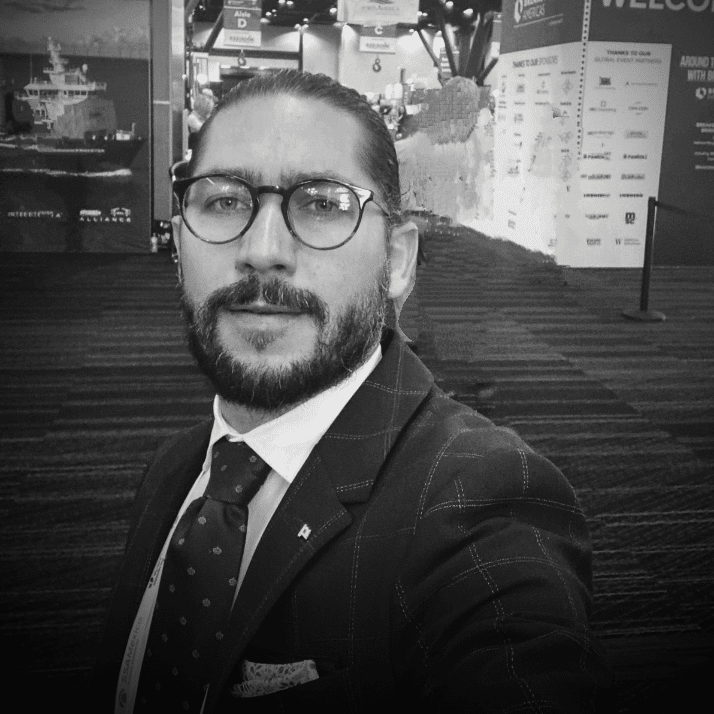After a quiet couple of weeks in the offshore drilling market, a variety of new drilling contracts were announced this week as rig contractors issued their quarterly earnings and fleet status reports.
In case you missed it, you can access our previous Rig Market Roundup here.
Contracts
The Valaris-owned 12,000-ft drillship, Valaris DS-7, has secured a new assignment for work off West Africa that will see it reactivated from cold stack. While the operator was not named, it is understood to be Azule Energy for work off Angola. The work scope consists of 12 wells starting in Q2 2024 and running for about 850 days. The total estimated contract value is $364 million. The contract requires minimal customer-specific upgrades to the rig and does not include the provision of any additional services. Azule also recently commenced a charter with 12,000-ft Saipem 12000 off Angola. This assignment runs into Q3 2025. Valaris DS-7 last worked until Q4 2019 off Egypt for Burullus. It has been stacked off Las Palmas in the Canary Islands and will now be reactivated for this charter. The five-year SPS is also likely to be conducted during the reactivation, as it is due in September 2023. Meanwhile, market sources indicate this rig was also offered to Petrobras on various tenders, including the still unawarded Buzios opportunity.
Borr Drilling 400-ft jackups Gerd and Thor have each received a binding letter of award. Gerd’s award is from an undisclosed operator for work in the Middle East. The term is 270 days plus an unpriced option for 60 days. The estimated contract value for the firm term is $47.7 million, which includes mobilisation and demobilisation. Gerd’s current charter with Addax off Cameroon is now expected to end in Q3 2023, after Addax decided not to proceed with certain optional wells it had previously exercised. Once released, the rig will undergo mobilisation, statutory surveys, and recertification ahead of its new commitment, which is scheduled to begin in December 2023. Thor’s new charter is from an undisclosed operator for work in Southeast Asia. The contract is for two wells over an estimated duration of 151 days. The estimated contract value is $25.1 million, including mobilisation and demobilisation. Operations are expected to begin in December 2023, in direct continuation with the rig’s current charter. Thor is currently operating off Thailand for CPOC.
Transocean has received a new short-term charter for the 12,000-ft drillship Deepwater Invictus for P&A work in the US Gulf. The rig recently completed about three months of work with Murphy. The new charter began in direct continuation and should run about 20 days. While the operator was not disclosed, it is understood to be Woodside for Green Canyon Block 520 in the Wildling field. Water depth at the well site is 4,054 ft.
Petrobras has disclosed the winning bids from Lots 1 and 2 in the pool tender for up to four floating rigs. From Lot 1, the 12,000-ft newbuild drillship Deepwater Aquila and the 10,000-ft Zonda have been named, and from Lot 2, the 10,000-ft Norbe VIII has been named. However, contracts are not final until after the appeal deadline has been passed. This is currently expected by the end of August. For Lot 3, Petrobras has updated the bidding status and adjudication. As reported by Esgian in May, Deepwater Aquila, Zonda, and Norbe VIII were the low bidders in their respective lots. The low bidder in Lot 3 was the 9,000-ft Alpha Star.
Shelf Drilling North Sea has secured a contract for the 400-ft jackup Shelf Drilling Fortress with CNOOC Petroleum Europe Limited for operations at the Golden Eagle platform in the UK Central North Sea. The firm term of the contract is two wells, approximating to between four and five months. The contract value for the firm period is approximately $17 million. The contract also includes options for additional wells with a total estimated duration of 13 months. The planned start-up of operations is September 2023. The rig, previously known as Noble Sam Hartley, is currently warm stacked in the UK following the completion of its contract with TotalEnergies in early 2023. It previously worked for CNOOC on the Golden Eagle field in 2020 and 2021.
Harbour Energy has secured two CJ70 jackup rigs from Noble for operations in Norway and the UK. Harbour Energy has awarded the 492-ft Noble Integrator a one-well contract for operations on the Norwegian Continental Shelf, with an estimated duration of 35 days and a dayrate of $205,000. The Noble Integrator is currently under firm contract with Aker BP in Norway until September 2023 followed by an option period through December. This will be followed by the Harbour contract, which is expected to start in January 2024. Furthermore, Harbour has awarded the 492-ft Noble Intrepid a ten-month contract for the provision of accommodation services at the Judy field in the UK sector of the North Sea, with a contract value of $28.5 million. The contract contains options to add up to five months of accommodation and well intervention services. Specifically, there are two one-month options for accommodation services at a dayrate of $95,000 and one three-month option for well intervention services at $120,000. The 492-ft rig has been warm stacked in the UK since late 2022 following the completion of its contract with OMV in Norway.
Drilling Activity and Discoveries
TotalEnergies drilled a successful appraisal well in the Krabdagu field off Suriname. Partner APA Corp. confirmed the Krabdagu-3 appraisal well confirmed the extension of oil resource 14 km from the discovery well. Appraisal of the Krabdagu fairway remains ongoing. APA stated that its focus in Suriname is on finishing the Krabdagu appraisal programme and scoping an oil hub project to develop the combined Sapakara and Krabdagu resource. No additional drilling will be needed off Suriname this year. Krabdagu-3 was drilled by Transocean 10,000-ft semisub Development Driller III, which is scheduled to be released in October. Market sources indicate Development Driller III has been offered into multiple opportunities for follow-on within the Americas.
Aker BP is preparing for drilling operations on the Storjo West well located in the Norwegian Sea with Saipem’s 10,000-ft semisub Scarabeo 8. The Norwegian Environment Agency has received an application from Aker BP for permission to drill exploration well 6507/2-7 Storjo West with the Scarabeo 8 rig. Drilling is planned to start in November 2023 and will last 85 days, including a well test. The exploration well is located in production licence 261 in the Norwegian Sea west of Skarv. The licence is operated by Aker BP with Wintershall Dea participating as a partner. The drilling location is 170 km from the Helgeland coast and the average water depth is 343 metres. The well is located 2.5 km west of the Storjo Øst exploration well, which was drilled in 2022 and encountered gas in several geological formations.
PetroRio advised that its 10,000-ft semisub Hunter Queen is in the final stages of preparations to begin work at the Wahoo field off Brazil. The rig, which is owned by PetroRio and managed by Foresea, will soon undergo inspections. Meanwhile, PetroRio is working to obtain the environmental licence to drill from IBAMA and expects to receive it within the coming months. Operations had previously been expected to start in August 2023. Following some work at Wahoo, Hunter Queen will then move to the Albacora field, likely around Q2 2024.
The Norwegian Petroleum Directorate (NPD) has granted OMV (Norge) a drilling permit for the Velocette well in the Norwegian Sea. The well 6607/3-1 S is located in production licence 1016, which is operated by OMV with INPEX Idemitsu Norge and Longboat Energy Norge participating as partners. The water depth at the site is 475 meters. The Velocette well is located approximately 47 km southeast of the Aasta Hansteen field and it will be drilled using the 10,000-ft semisub Transocean Norge. OMV secured safety consent for the well from the Norwegian authorities in July. Drilling is expected to have a maximum duration of 117 days. The rig is currently drilling the Bergknapp appraisal well for Wintershall Dea.
Norway’s Petroleum Safety Authority (PSA) has given Equinor consent to use the 2,460-ft COSLPromoter semisub for production drilling on Statfjord Øst and Nord offshore Norway. The consent includes the use of the COSLPromoter for P&A, production drilling, and completion of two additional wells: M-1 BH on Statfjord Øst, and F-4 CH on Statfjord Nord. Statfjord Øst is a field in the Tampen area in the North Sea, seven kilometres northeast of the Statfjord field. The water depth in the area is 150-190 metres. Statfjord Nord is a field in the Tampen area in the northern part of the North Sea, 17 kilometres north of the Statfjord field. The water depth in the area is 250-290 metres. COSLPromoter has been working for Equinor in Norway for years and its current firm term is expected to run through Q1 2024 with options thereafter.
Demand
Petrobras has launched a new tender for a single moored floating rig. The term is for 1,250 days, plus an option for up to the same period. The mobilisation period is 365 days from contract signing. The contract start window is between January and March 2025. This follows on the tender launched on 21 July for up to three high-spec rigs to start work in 2025. Bids for the moored rig tender are due by 18 August 2023.
ONGC has opened commercial bids for the supply of an ultra-deepwater drillship for 21 months, starting in Q3/Q4 2023. The scope of work within the tender was revised prior to the opening of the commercial bids from two to one ultra-deepwater drillship capable of operating in water depths of 3,000 m (9,000 ft). Transocean emerged as the lowest bidder with the 12,000-ft Dhirubhai Deepwater KG1 with an estimated dayrate of $350,000. Market sources indicate that Transocean also offered the 12,000-ft Discoverer Inspiration and Vantage Drilling offered the 12,000-ft Platinum Explorer and the 10,000-ft Seadrill-owned West Polaris. Dhirubhai Deepwater KG1 is a 6th generation drillship of a Samsung 10000 design. KG1 is currently operating for Reliance in India. The contract is expected to end in November 2023.
Mobilisation/Rig Moves
Stena Drilling’s 10,000-ft drillship, Stena Forth, has arrived in Egypt before its upcoming contract with Shell in the Mediterranean. Following a recent completion of a contract with Chevron in Cyprus, the drillship arrived in Abu Qir, Egypt on Monday 31 July 2023. The three-well contract with Shell was announced in January 2023 and it is expected to start soon. The project will require Managed Pressure Drilling (MPD) utilising the system owned and installed by Stena Drilling on the Stena Forth.
The 10,000-ft drillship Stena DrillMAX has completed its five-year SPS in the Canary Islands and is returning to Guyana. The rig is due to arrive on or about 12 August. It will resume its commitment with ExxonMobil. Stena DrillMAX is committed through the first half of 2024 and has rolling options available.
Ocean Oilfield’s 280-ft jackup Aras Driller has commenced operations with Atlantis (UAQ) Limited offshore United Arab Emirates (UAE) Aras Driller arrived at Hamriyah Shipyard in Sharjah in May 2023, where the rig performed its Underwater Inspection in Lieu of Drydocking (UWILD) Class Survey. The rig commenced its operations with Atlantis (UAQ) Limited on 27 July 2023. The term of the contract has an estimated duration of 3-4 months. Ocean Oilfield has been actively marketing the rig to keep it busy after this P&A campaign.
Valaris’ 12,000-ft drillship Valaris DS-17 is expected to commence its charter with Equinor off Brazil this month following customer acceptance. The rig arrived on 6 June following its reactivation and mobilisation from the Canary Islands. Equinor plans to use the rig primarily for the Bacalhau development. This rig has also been authorised to drill the Argerich-1 well off Argentina during a window between mid-December 2023 and mid-June 2024. Valaris DS-17 is committed to Equinor until February 2025. The operator also has two priced options, each with an estimated duration of 60 days.
Noble expects to redeploy its 400-ft jackup Noble Regina Allen by mid-2024 following repairs at a shipyard in the Netherlands. The Noble Regina Allen experienced a mechanical failure with the jacking system of one of its legs in mid-December 2022 after which its contract with EOG Resources in Trinidad & Tobago was terminated early. Before that happened, the contract was expected to continue into September 2023. In February 2023, Noble said that the rig would be out for the rest of the year. Following the mechanical failure, the rig was demobilised to a port in Trinidad with plans for potential redeployment in the second half of 2023, left Trinidad in April 2023, and arrived in Rotterdam on 27 April. In its quarterly earnings call on Thursday, Noble stated that the repairs are now expected to be completed in early 2024 and the rig redeployed by mid-2024. Noble has good contract visibility outside of the North Sea for this rig once it becomes available. The rig previously worked in Canada, Trinidad and Tobago, and Guyana.
Other News
Hundreds of new oil and gas licences will be granted in the UK as part of efforts to boost the UK’s energy independence, Prime Minister Rishi Sunak confirmed on Monday 31 July 2023. The UK government and the North Sea Transition Authority (NSTA) are announcing a joint commitment to undertake future licensing rounds, which will continue to be subject to a climate compatibility test. By adopting a more flexible application process, licences could also be offered close to currently licensed areas – unlocking reserves which can be brought online faster due to existing infrastructure and previous relevant assessments. The NSTA is currently running the 33rd offshore oil and gas licensing round, which was launched in October 2022 and closed in January 2023. The regulator expects the first of the new licences to be awarded in the autumn, with the round expected to award over 100 licences in total. The first licences were previously expected to be awarded in Q2 2023. This comes as a new analysis released by the NSTA shows that the carbon footprint of domestic gas production is around one-quarter of the carbon footprint of imported liquified natural gas. A call for evidence has also been launched by the government, seeking views on the evolving context for taxes for the oil and gas sector to design a long-term fiscal regime which delivers predictability and certainty, supports investment, and protects jobs and the country’s energy security. However, this does not include the Energy Profits Levy (EPL). As a reminder, the UK government in June 2023 decided to make changes to the EPL, also known as the windfall tax, that will see the current total 75% tax rate removed if oil and gas prices fall to certain levels for two consecutive quarters and returned to 40%.
The UK government has confirmed that projects Acorn in North East Scotland and Viking in the Humber have been chosen as the third and fourth carbon capture usage and storage (CCUS) clusters in the UK. The government has already committed to deploying CCUS in two industrial clusters by the mid-2020s – the HyNet cluster in North West England and North Wales, and the East Coast Cluster in the Teesside and Humber – and another further two clusters by 2030 – now confirmed as Storegga-operated Acorn and Harbour Energy’s Viking. The government has committed to providing up to £20 billion in funding for the early deployment of CCUS. Together, these four clusters will build a carbon capture usage and storage industry, which could support up to 50,000 jobs in the UK by 2030, according to the government. Harbour Energy says that this marks an important milestone for the two projects, allowing them to move into front-end engineering and design (FEED) and discussions with the government over the terms of the economic licences, ahead of final investment decisions. Viking has the potential to transport and store up to 10 million tonnes of CO2 annually by 2030 and 15 million tonnes of CO2 annually by 2035 with an independently verified storage capacity of 300 million tonnes of CO2 across the depleted Viking gas fields. Acorn has been progressed by the development partners as the Track-1 reserve since late 2021 and is ready to move promptly. Entering the Track-2 process will allow Acorn to begin detailed negotiations with the government and to continue working to provide the infrastructure to support the decarbonisation of emitters across Scotland.
Transocean has recorded Q2 2023 contract drilling revenues of $729 million, up from $649 million in Q1 2023. The company reported a net loss attributable to controlling interest of $165 million for Q2 2023. After adjusting for net unfavourable items, the Q2 2023 net loss was $110 million. The $80 million increase in drilling revenues was primarily attributable to increased activity for rigs that returned to work after being idle in Q1, commencement of operations of 12,000-ft newbuild drillship Deepwater Titan, and $19 million associated with the early termination of 1,640-ft Transocean Endurance and 10,000-ft Transocean Barents, partially offset by reduced activity for two rigs that were idle during Q2. “During the second quarter, we continued to benefit from increased demand for our fleet of high-specification floaters. As of our latest fleet status report, we secured an additional $1.2 billion of backlog at a weighted average dayrate of approximately $456,000,” said Transocean CEO, Jeremy Thigpen. “As evidenced by our customers contracting rigs well in advance of their programs and committing to long-term contracts, the outlook for our high-specification assets and services remains robust.”
Offshore drilling contractor Valaris booked a loss in the second quarter of 2023 as its revenues decreased from the previous quarter due to fewer operating days on its jackup fleet. Valaris’ net loss in Q2 2023 was $27 million compared to net income of $49 million in the first quarter of 2023. Revenues decreased to $415 million from $430 million in the first quarter of 2023. Excluding reimbursable items, revenues decreased to $390 million from $408 million in the first quarter. The decrease was primarily due to fewer operating days for the jackup fleet and lower mobilisation and demobilisation revenues. These were partially offset by an increase in the average dayrate for both floaters and jackups. Valaris President and Chief Executive Officer, Anton Dibowitz, said: “Our outlook for the industry and our business remains very positive, with increasing demand and constrained supply tightening the market. We continue to see increases in contract duration, lead times and dayrates, all of which point towards a strong and sustained upcycle. Our earnings and cash flow should grow meaningfully over the next few years as rigs roll from legacy dayrate contracts to higher market rates and reactivated rigs return to work on attractive contracts.”
Valaris has stated its intention to exercise its options to purchase the 12,000-ft drillships Valaris DS-13 and Valaris DS-14. Both rigs are located at Hanwha Ocean (formerly known as Daewoo Shipbuilding and Marine Engineering) in South Korea. Valaris plans to move them to Las Palmas, where they will be positioned alongside the 12,000-ft drillship Valaris DS-7. The company had previously indicated it was planning to exercise the option for Valaris DS-13 and was still considering its options regarding Valaris DS-14. Valaris DS-7 recently secured a charter that will see it reactivated for work off West Africa. The reactivation cost is estimated at $90 million plus $10 million for customer-specific upgrades. Valaris noted that the contract award “includes meaningful upfront payment” and represents their seventh floater reactivation. The purchase price for Valaris DS-13 is $119 million and $218 million for Valaris DS-14. Valaris noted both rigs will be delivered with dual BOPs without an additional investment. The company estimates adding a second BOP to a rig with a single stack could run about $50 million at current market prices. For comparison, the other newbuild drillships in South Korea were ordered with single BOP stacks. Purchase prices of some of these units last year and so far this year have ranged from about $200-245 million plus any requested upgrades. As part of the purchase agreement with Stena Drilling for the 12,000-ft Stena Evolution (ex-Ocean Rig Crete), the rig will be delivered with dual BOP stacks. Following the contract award for Valaris DS-7, Valaris is now left with only one cold drillship – the 12,000-ft Valaris DS-11. The contractor says the decision on whether to put this rig or one of the two newbuilds to work first will ultimately depend on what the customer is looking for, as the specs on all three units are very similar.
Noble Corporation reported net income of $66 million and stated that the company is committed to return capital to shareholders through its $60 million share purchase program and initiating quarterly dividend at $0.30 per share. Noble reported contract drilling services revenue of $606 million for the second quarter of 2023, which is a 5.4% increase from the previous quarter, while maintaining its contract drilling services cost from Q1 2023. Adjusted EBITDA increased to $188 million in Q2 2023 versus $138 million in Q1. Noble’s President and CEO, Robert W. Eifler said: “Offshore fundamentals remain exceptionally strong, supporting a steady upward progression in contract status across our fleet. We expect UDW market tightness to persist and drive further upward pressure on dayrates going forward. With Adjusted EBITDA and Free Cash Flow expected to increase in the second half of the year versus the first half, we remain focused on maximizing shareholder value through best-in-class execution and returning the significant majority of free cash flow to shareholders.” For 2023, Noble’s guidance for total revenue is in the range of $2.35 to $2.55 billion, adjusted EBITDA of $725 to $825 million, and capital expenditures (net of reimbursable capex) between $325 and $365 million.
Eni has revoked the force majeure status on exploration area C offshore Libya, along with onshore areas A and B. Eni operates the three areas with 42.5% interest, along with partners bp (42.5%) and the Libyan Investment Authority (15%). Force majeure was declared in 2014. The revocation came about after Eni completed a security risk assessment concerning the conditions in the areas where the exploration programme will be carried out and found positive results. Eni has been operating in Libya since 1959 and has a large portfolio of assets under exploration, production, and development. Production activities are operated through the joint venture company Mellitah Oil and Gas.
Petrobras has informed the market that its board of directors would be considering the possible conclusion of an agreement with Sete Brasil and the companies of its economic group. Additional details were not made available due to confidentiality agreements. The meeting took place on 3 August 2023. In its notice, Petrobras referenced an announcement from January 2021. In this announcement, Petrobras states that it received notice from Sete Brasil that it would not be able to comply with certain conditions in its agreement and was requesting the start of a new negotiation with Petrobras. The executive board of Petrobras authorised commencing new negotiations with Sete Brasil. As a reminder, in 2018, Petrobras planned to contract the remaining four Sete rigs for 10 years each at a dayrate of $299,000 per rig. Magni Partners, Mubadala Investment Company, and Etesco later agreed to participate in Sete and aid in progressing the deal. The four rigs concerned are drillships Arpoador and Deepsea Guarapari, and semisubs Frade and Urca.
Hibiscus Petroleum’s subsidiary, Anasuria Hibiscus UK Limited, has received a Development and Production Works Consent to a Field Development Plan (FDP) for the Teal West field in the UK North Sea from the North Sea Transition Authority (NSTA). The FDP approval comes pursuant to the unconditional grant of consent for the Environmental Statement (ES) received on 7 July 2023. The consent granted is subject to adherence to the FDP submitted and the standard requirement to seek additional approval in the event there is any incremental development proposed in the course of the carrying out the works. The next stage after the FDP approval is the internal Final Investment Decision (FID) which if proceeded with, would result in the first oil from the Teal West field expected by late 2024/early 2025. The project is located in UK Licence P.2535 Block 21/24d in the Central North Sea. Phase 1 will consist of drilling one production well and, depending on the success of this phase, Phase 2 will involve the drilling of a water injection well at the west of the same structure. If both of these indicate the potential for high oil volumes, a second production well will be drilled in Phase 3. The wells will be tied back to the existing Anasuria FPSO.
Image: JU Noble Integrator; Credit: Noble



















































































